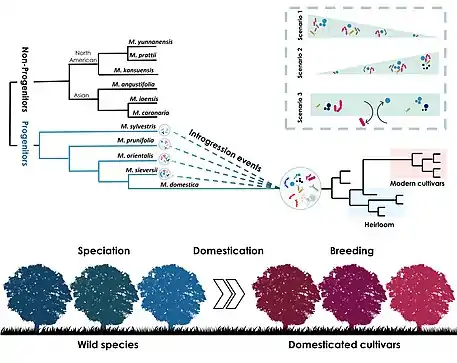Phylosymbiosis
In the field of microbiome research, a group of species is said to show a phylosymbiotic signal if the degree of similarity between the species' microbiomes recapitulates to a significant extent their evolutionary history.[1] In other words, a phylosymbiotic signal among a group of species is evident if their microbiome similarity dendrogram could prove to have significant similarities with their host's phylogenic tree. For the analysis of the phylosymbiotic signal to be reliable, environmental differences that could shape the host microbiome should be either eliminated or accounted for. One plausible mechanistic explanation for such phenomena could be, for example, a result of host immune genes that rapidly evolve in a continuous arms race with members of its microbiome.
In animals
Across the animal kingdom there are many notable examples of phylosymbiosis. For instance, in non-human primates it was found that host evolutionary history had a substantially greater influence on the gut microbiome than either host dietary niche or geographic location.[2] It was speculated that changes in gut physiology within the evolutionary history of non-human primates was the primary reason. This finding was particularly interesting as it contradicted previous research which reported that dietary niche was a strong factor in determining the gut microbiome of mammals.[3][4][5]
Plants

phylosymbiosis has been reported in several plant groups including Malus[6] and Poaceae.[7] In the former case, Malus species, including wild wild and domesticated cultivars, harbored endophytic communities that corresponded to their phylogenetic relationship.[6]
See also
References
- W. Brooks, Andrew (November 18, 2016). "Phylosymbiosis: Relationships and Functional Effects of Microbial Communities across Host Evolutionary History". PLOS Biology. 14 (11): e2000225. doi:10.1371/journal.pbio.2000225.g004. PMC 5115861. PMID 27861590.
- Katherine R. Amato; Jon G. Sanders; Se Jin Song; et al. (11 July 2018). "Evolutionary trends in host physiology outweigh dietary niche in structuring primate gut microbiomes". The ISME Journal. 13 (3): 576–587. doi:10.1038/S41396-018-0175-0. ISSN 1751-7362. PMC 6461848. PMID 29995839. Wikidata Q57735585.
- Frédéric Delsuc; Jessica L Metcalf; Laura Wegener Parfrey; Se Jin Song; Antonio González; Rob Knight (7 October 2013). "Convergence of gut microbiomes in myrmecophagous mammals". Molecular Ecology. 23 (6): 1301–1317. doi:10.1111/MEC.12501. ISSN 0962-1083. PMID 24118574. Wikidata Q35015637.
- Gordon, Jeffrey I.; Knight, Rob; Schrenzel, Mark D.; Tucker, Tammy A.; Schlegel, Michael L.; Bircher, J. Stephen; Ramey, Rob Roy; Turnbaugh, Peter J.; Lozupone, Catherine (2008-06-20). "Evolution of Mammals and Their Gut Microbes". Science. 320 (5883): 1647–1651. Bibcode:2008Sci...320.1647L. doi:10.1126/science.1155725. ISSN 1095-9203. PMC 2649005. PMID 18497261.
- Gordon, Jeffrey I.; Knight, Rob; Henrissat, Bernard; Fontana, Luigi; González, Antonio; Clemente, Jose C.; Knights, Dan; Kuczynski, Justin; Muegge, Brian D. (2011-05-20). "Diet Drives Convergence in Gut Microbiome Functions Across Mammalian Phylogeny and Within Humans". Science. 332 (6032): 970–974. Bibcode:2011Sci...332..970M. doi:10.1126/science.1198719. ISSN 1095-9203. PMC 3303602. PMID 21596990.
- Abdelfattah, Ahmed; Tack, Ayco J. M.; Wasserman, Birgit; Liu, Jia; Berg, Gabriele; Norelli, John; Droby, Samir; Wisniewski, Michael (2021). "Evidence for host–microbiome co-evolution in apple". New Phytologist. 234 (6): 2088–2100. doi:10.1111/nph.17820. ISSN 1469-8137. PMID 34823272. S2CID 244661193.
- Bouffaud, Marie-Lara; Poirier, Marie-Andrée; Muller, Daniel; Moënne-Loccoz, Yvan (2014). "Root microbiome relates to plant host evolution in maize and other Poaceae". Environmental Microbiology. 16 (9): 2804–2814. doi:10.1111/1462-2920.12442. ISSN 1462-2920. PMID 24588973.